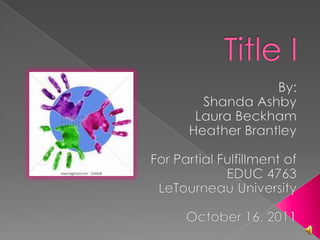
Differentiating classroom instruction power point 1
- 1. Title I By: Shanda Ashby Laura Beckham Heather Brantley For Partial Fulfillment of EDUC 4763 LeTourneau University October 16, 2011
- 2. What is Title I? Title I is the nation’s oldest and largest federally funded program according to the United States Department of Education. Title I is a program that was created in the Elementary and Secondary Act as reauthorized by the No Child Left Behind Act of 2001. It was also mentioned in the American Recovery and Reinvestment Act of 2009.
- 3. Program Purpose Title I was created to ensure that all children have a fair, equal, and significant opportunity to obtain a high-quality education Students must also reach, at a minimum, the proficiency levels of challenging state academic achievement standards and state academic assessments.
- 4. Basic Principles of Title I The principles of Title I state that schools with large concentrations of low-income students will receive supplemental funds to assist meeting student’s educational goals. Low-income students are determined by the number of students enrolled in the free and reduced lunch program. For an entire school to qualify for Title I funds, at least 40% of students must enroll in the free and reduced lunch programs.
- 5. Who Does it Affect? Title I serves a variety of subpopulations within schools: Economically disadvantaged children Limited English proficiency children Migratory children Children with disabilities Indian children Neglected or delinquent children Young children in need of reading assistance Or any at-risk student or student in need
- 6. Use of Program and Funds Funding is used to guaranty that students, teachers, parents, and administrators can measure academic achievement progress against common expectations. Program funding also seeks to close the achievement gap between high- and low-performing students and between advantaged and disadvantaged children. It also provides alternatives to students from low-performing schools so that students are able to receive a high-quality education. Students also receive an enriched and accelerated educational program.
- 7. Qualification Requirements Schools must meet financial requirements that are based on the level of poverty at each campus. Children that are eligible for free and/or reduced price lunches under the National School Lunch Act are eligible. Individual student requirements include those students who are scoring below 70% in the Reading and Math Accelerated Instruction Program at the beginning of the year. Sometimes children are considered based on teacher recommendation. Teachers may also recommend a student who is failing in math and reading.
- 8. Instructional Requirements Teachers and paraprofessionals must be highly qualified. Most schools are required to have 100% highly qualified teachers and staff employed on campus. Title I teachers must coordinate with homeroom teachers to ensure that curriculum in the classroom is reinforced during small group. TEKS are used in writing lesson plans for accelerated instruction in the state of Texas. Tutoring opportunities are available that meet the specific needs of students. This allows opportunities for differentiated instruction and intervention in the school.
- 9. Teacher-Specific Regulations Regarding Implementation Teachers are held accountable for student performance. Teachers and paraprofessionals must be highly qualified. They must continue in their professional development which might include attending workshops, reading articles and books, and taking online classes. Teachers are also required to provide proof of monitored student progress at their school district in the required core subjects as required by Title I. The curriculum must be challenging to the students which in-turn gives teachers a more demanding job to perform.
- 10. Controversy With Title I Teacher comparability is becoming a hot button issue with teachers’ unions, civil rights groups, and researchers. School districts will be required to provide equitable state and local resources to both low- and high-income schools. Expenditures are also required to be the same in both low- and high-income schools. Higher income schools will have more available funds to pay their already higher paid teacher’s salaries.
- 11. References Bullard ISD. Title 1 Entrance/Exit Criteria. (2011, August). Bullard, TX. California Department of Education. (2011, July 29). Compliance monitoring, intervention, and sanctions. Retrieved from http://www.cde.ca.gov/nclb/sr/tq/tiicmis.asp. Cohen, J. (2011, October 11). Harkin’s ESEA reauthorization bill makes strides in fixing Title I teacher comparability. Retrieved from http://edmoney.newamerica.net/blogposts/2011/harkins_esea_reauthorization_bill_makes_strides_in_fixing_title_i_teacher_comparabili. Green, C. (2010, February 1). Guidance for the implementation of Title I, Part A: Improving basic programs operated by local education agencies. Retrieved from www.tea.state.tx.us/WorkArea/linkit.aspx?LinkIdentifier=id&ItemID=2147488052&libID=2147488051. Malburg, S. (2011, October 5). Understanding the basics of Title 1 funds. Retrieved from http://www.brighthub.com/education/k-12/articles/11105.aspx. Texas Education Agency. Glossary of terms, 2007-08: Division of accountability research. Retrieved from http://ritter.tea.state.tx.us/acctres/gloss0708.html. U.S. Department of Education. (2004, September 15). Title I: Improving the academic achievement of the disadvantaged. Retrieved from http://www2.ed.gov/policy/elsec/leg/esea02/pg1.html. U.S. Department of Education. (2004, March 1). Title I paraprofessionals: Non-regulatory guidance. Retrieved from www2.ed.gov/policy/elsec/guid/paraguidance.doc.